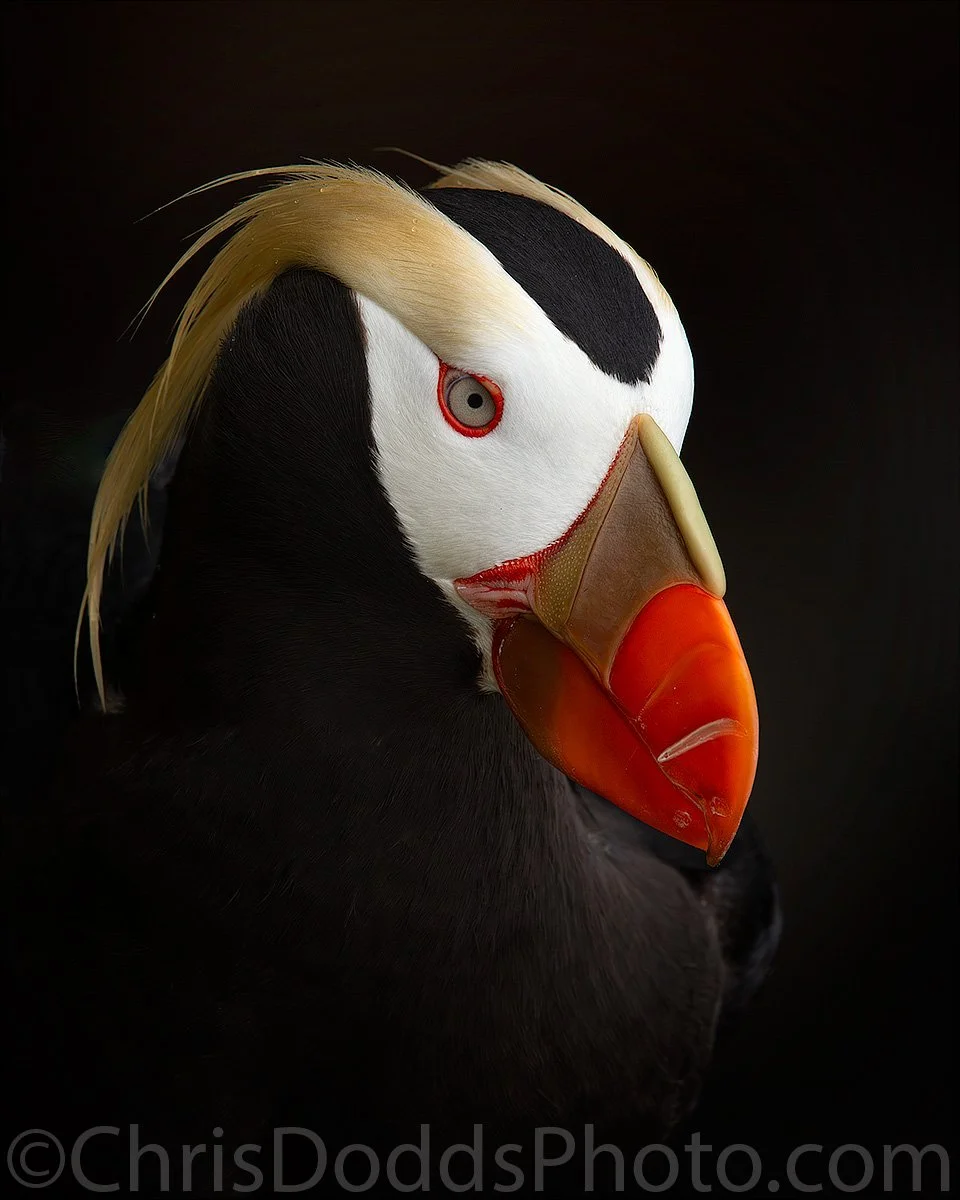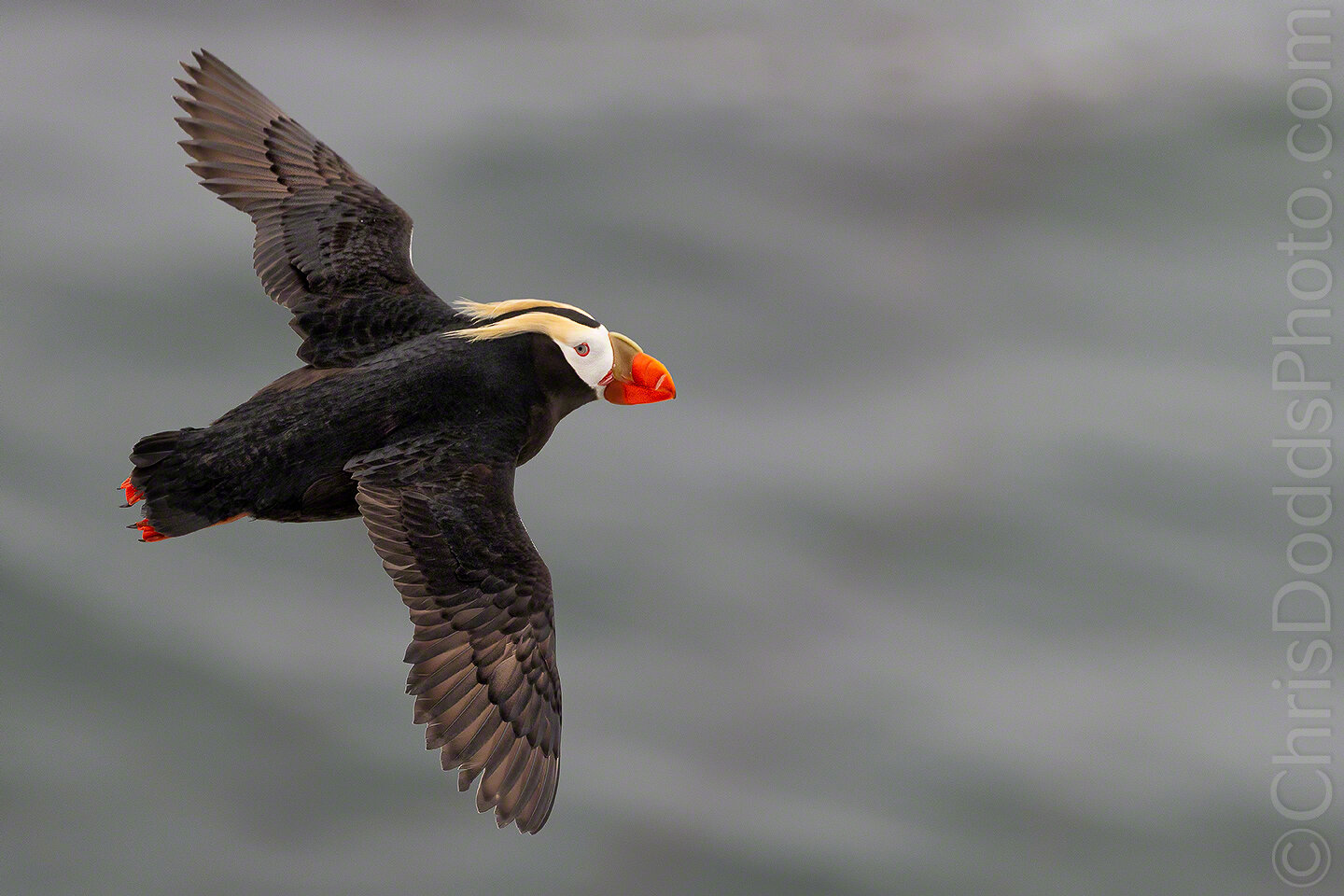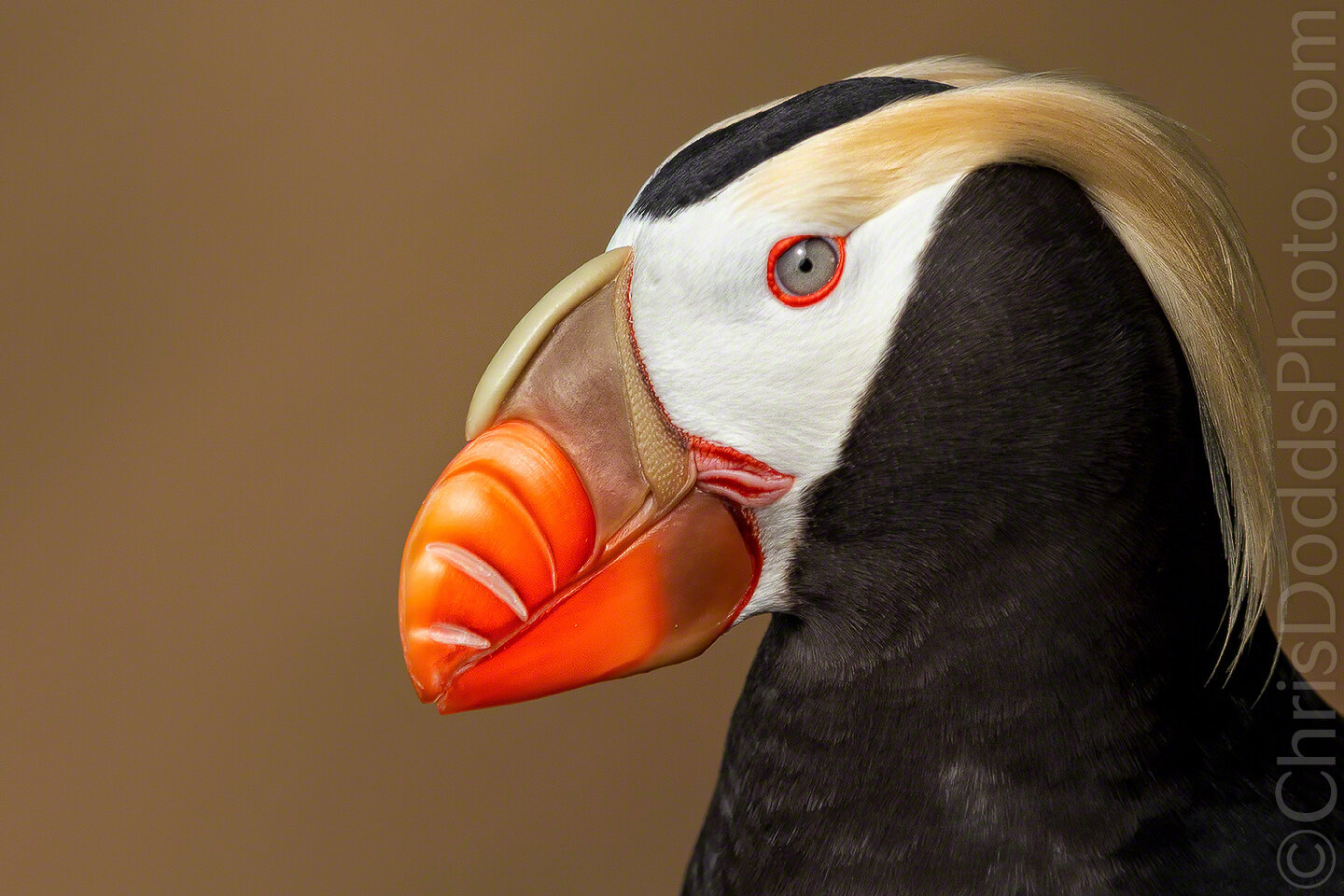 Tufted Puffin In Flight #1 (Fratercula cirrhata, Macareux huppé, TUPU) Saint Paul Island, The Pribilof Islands in the Bering Sea, Alaska. Image Copyright ©Christopher Dodds. Canon EOS 1DMKIV, 70-300mm f/4-5.6 L IS USM @300mm. ISO 1,600, f/5.6 @ 1/3,200s Manual Mode Full Frame. PURCHASE A PRINT or LICENSE IMAGE FOR PUBLICATION HERE.
Tufted Puffin In Flight #1 (Fratercula cirrhata, Macareux huppé, TUPU) Saint Paul Island, The Pribilof Islands in the Bering Sea, Alaska. Image Copyright ©Christopher Dodds. Canon EOS 1DMKIV, 70-300mm f/4-5.6 L IS USM @300mm. ISO 1,600, f/5.6 @ 1/3,200s Manual Mode Full Frame. PURCHASE A PRINT or LICENSE IMAGE FOR PUBLICATION HERE.
Photographing birds in flight in low light is quite challenging; it's not easy. I love photographing seabirds, and that often means shooting small, and often erratically moving targets; fast and unpredictable little fliers from the top of coastal cliffs in bad weather. The biggest problem to overcome is our need to always grab our longest lens and our reluctance to shoot wide open at high ISO (for Canon users, anyway). I recently had a discussion with a photographer who told me he didn't need a camera capable of shooting 10 fps (frames per second); he timed the wingbeats and only took one frame at a time. Well, let's just say that was one photographer who had a couple of good birds in flight images in his portfolio, but Florida Great Blue Herons are tame, huge, fly slowly and do have predictable wingbeats. What I want to share today is how I succeed (more, or less) at shooting bullets that move at 55 MPH with 100-400 wing beats per minute; I'm talking, of course, about photographing Puffins in flight. I was fortunate to photograph all three North American species of Puffins this summer, on both the East, and west coast. In June I hosted my annual Puffins Galore (and so much more) workshop for the Atlantic Puffin, and then I photographed the Horned and Tufted Puffins of Saint Paul Island (more images to come soon).
 Tufted Puffin In Flight #2 (Fratercula cirrhata, Macareux huppé, TUPU) Saint Paul Island, The Pribilof Islands in the Bering Sea, Alaska. Image Copyright ©Christopher Dodds. Canon EOS 1DMKIV, 70-300mm f/4-5.6 L IS USM @300mm. ISO 1,600, f/5.6 @ 1/3,200s Manual Mode Full Frame. PURCHASE A PRINT or LICENSE IMAGE FOR PUBLICATION HERE.
Tufted Puffin In Flight #2 (Fratercula cirrhata, Macareux huppé, TUPU) Saint Paul Island, The Pribilof Islands in the Bering Sea, Alaska. Image Copyright ©Christopher Dodds. Canon EOS 1DMKIV, 70-300mm f/4-5.6 L IS USM @300mm. ISO 1,600, f/5.6 @ 1/3,200s Manual Mode Full Frame. PURCHASE A PRINT or LICENSE IMAGE FOR PUBLICATION HERE.
First of all, get over your phobia of shooting wide open and using a high ISO. You are going to need a shutter speed of at least 1/2,500 of a second, but I prefer 1/3,200 of a second to freeze the fast action; this usually means using an ISO of at least 1,600 and an aperture of at least f/5.6 (always in manual mode). I try to get as close as possible in low light and low contrast conditions; I try to use the shortest lens possible, while trying to fill the frame. Using only the centre auto-focus point only usually helps the autofocus system lock onto your subject, but it's going to take more than relying on your camera to acquire focus. I generally try to pick-up repetitive flight patterns; I try to predict where the bird I am trying to shoot will fly and pre-focus on something near there so the auto-focus system doesn't have to spin the lens much to acquire sharp focus. Once locked-on to my subject, it's all up to me to keep the focus point on the subject and hit the stutter button at 10 fps; the best way to be able to do that is practice; over, and over again.
 Tufted Puffin In Flight #3 (Fratercula cirrhata, Macareux huppé, TUPU) Saint Paul Island, The Pribilof Islands in the Bering Sea, Alaska. Image Copyright ©Christopher Dodds. Canon EOS 1DMKIV, 70-300mm f/4-5.6 L IS USM @300mm. ISO 1,600, f/5.6 @ 1/3,200s Manual Mode Full Frame. PURCHASE A PRINT or LICENSE IMAGE FOR PUBLICATION HERE.
Tufted Puffin In Flight #3 (Fratercula cirrhata, Macareux huppé, TUPU) Saint Paul Island, The Pribilof Islands in the Bering Sea, Alaska. Image Copyright ©Christopher Dodds. Canon EOS 1DMKIV, 70-300mm f/4-5.6 L IS USM @300mm. ISO 1,600, f/5.6 @ 1/3,200s Manual Mode Full Frame. PURCHASE A PRINT or LICENSE IMAGE FOR PUBLICATION HERE.
I decided to post three sequential, full frame images of Tufted Puffins from a recent trip to Saint Paul Island (The Pribilof Islands), Alaska to demonstrate that it is possible to pull off what seems like the impossible. I left my tried, tested and true Canon EF 300mm f/2.8L IS II USM Telephoto Lens at home, instead opting for my favorite new 70-300mm f/4-5.6 L IS USM and threw it on my Canon EOS 1DMKIV. I set-up my exposure in manual mode and checked the histogram to make sure the blacks from the wet rocks below the cliffs I was standing on weren't blocked-up against the left edge to minimize noise, and carefully made sure I had no over-exposed whites on the right edge to ensure the most detail in the whites. Once sure of my exposure, I watched for the Puffins flight path and pre-focused on a rock where I thought the bird would fill the frame. Now pre-focused on the rock, I saw the bird fly in and followed it until it started to fill the frame, partially depressed the shutter button to activate the auto-focus system and hit the trigger at its maximum capture rate of 10 fps. Truth be told; I waited a fraction of a second too long for this sequence, and ran the risk of clipping the Puffin's wing-tips, but it worked-out fine with three action shots that I liked enough to keep (No, I won't teach you how to reconstruct the wingtips if you clip them, but I will teach you how to capture the image right, in the camera - smile).
Which of the three images here is your favorite & why? Leave a comment and you could win a free copy of the new Mac editing software FirstPass.
Great news! Jobu Designs (makers of my favorite Gimbal Head - the Jobu Jr. 3), Think-Tank Photo, Cotton Carrier, have all jumped on-board and offered tons of prizes to show their suppoort for my Second Annual Photo Geek Christmas Party. I expect other sponsors to make offerings and encourage contributions - email me if you would like to donate and promote your product chris(at)chrisdoddsphoto(dot)com
Join me, Canadian nature photographer Christopher Dodds, on November 30, 2011 at 7:30 PM at the Hudson Village Theatre (28 Wharf Road, Hudson, QC J0P 1H0) for an hour and a half long slideshow presentation to benefit this great cause which is so close to my heart. The show is designed to be entertaining and informative to all; nature lovers and photographers alike. Stories of adventure, natural history facts and information are all on the menu and this show is designed to offer helpful tips & techniques sure to improve your photography efforts with everything from a camera phone, point & shoot camera or professional SLR camera system. Over one hundred of my images will be projected, many unseen. Everyone is welcome!
Hurry! Only 148 seats. Tickets are only $15.00 each and are available for advance purchase only - every penny is collected by, and goes to Le Nichoir. Please call or email Le Nichoir (communication@lenichoir.org 450-458-2809) to secure your tickets, or make a donation if you can't make it (be sure to tell them it's on behalf of Chris' Photo Geek Christmas Party) Major credit cards and cheques accepted. Finger food and hors d'oeuvres are included and there will be a cash bar (please drink responsibly).
There will be ample time to mingle, meet my friends and contacts and share some of your images with others, so feel free to bring prints, iPads or laptops with your favourite images to share. I hope to see you there and PLEASE SPREAD THE WORD!
Read more about it HERE








